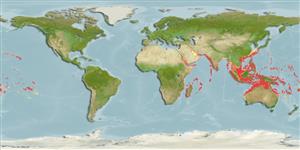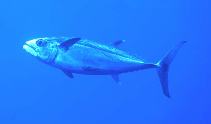Gymnosarda unicolor (Rüppell, 1836)
Dogtooth tuna
إضافة ملاحظاتك Fish Watcher
| Native range | All suitable habitat | Point map | Year 2050 |

|
| This map was computer-generated and has not yet been reviewed. |
| Gymnosarda unicolor AquaMaps Data sources: GBIF OBIS |
ارفع صور و مقاطع فيديو
Pictures | Videos | صور قوقلGymnosarda unicolor
Picture by Patzner, R.
Pictures | Videos | صور قوقلGymnosarda unicolor
Picture by Patzner, R.
Maldives country information
Common names:
Dogtooth tuna, Thon à gros yeux, Worhimas
Occurrence: native
Salinity: marine
Abundance: | Ref:
Importance: | Ref:
Aquaculture: | Ref:
Regulations: | Ref:
Uses: no uses
Comments: Also Ref. 168, 5579.
National Checklist:
Country Information: https://www.cia.gov/library/publications/resources/the-world-factbook/geos/mv.html
National Fisheries Authority:
Occurrences: Occurrences Point map
Main Ref: Randall, J.E. and C. Anderson, 1993
National Database:
Occurrence: native
Salinity: marine
Abundance: | Ref:
Importance: | Ref:
Aquaculture: | Ref:
Regulations: | Ref:
Uses: no uses
Comments: Also Ref. 168, 5579.
National Checklist:
Country Information: https://www.cia.gov/library/publications/resources/the-world-factbook/geos/mv.html
National Fisheries Authority:
Occurrences: Occurrences Point map
Main Ref: Randall, J.E. and C. Anderson, 1993
National Database:
Common names from other countries
التصنيف / Names الأسماء الشائعة | مرادفات | Catalog of Fishes(جنس, الانواع) | ITIS | CoL | WoRMS | Cloffa
> Scombriformes (Mackerels) > Scombridae (Mackerels, tunas, bonitos) > Scombrinae
Etymology: Gymnosarda: Greek, gymnos = naked + Greek, sarde = sardine; 1598 (Ref. 45335).
More on author: Rüppell.
Etymology: Gymnosarda: Greek, gymnos = naked + Greek, sarde = sardine; 1598 (Ref. 45335).
More on author: Rüppell.
Environment: milieu / climate zone / depth range / distribution range البيئة
بحري مرتبطة بالشعاب; محيطية (Ref. 51243); نطاق العمق 0 - 250 m (Ref. 86942). Tropical; 20°C - 28°C (Ref. 5313); 31°N - 30°S, 32°E - 130°W (Ref. 168)
التوزيع دول | مناطق الفاو | النظام البيئي | الظهور | Point map | مقدمة | Faunafri
Indo-Pacific: Red Sea and East Africa to French Polynesia, north to Japan, south to Australia.
الحجم / وزن / العمر
Maturity: Lm ? range ? - ? cm
Max length : 248 cm FL ذكر/ مختلط الجنس; (Ref. 40637); common length : 190 cm NG ذكر/ مختلط الجنس; (Ref. 9710); أعلا وزن تم نشرة: 131.0 kg (Ref. 168)
Max length : 248 cm FL ذكر/ مختلط الجنس; (Ref. 40637); common length : 190 cm NG ذكر/ مختلط الجنس; (Ref. 9710); أعلا وزن تم نشرة: 131.0 kg (Ref. 168)
وصف مختصر مفاتيح التعريف | الوصف الخارجي | قياسات المظهر الخارجي
الأشواك الظهرية (المجموع) : 13 - 15; الأشعة الظهرية الناعمة (المجموع) : 12 - 14; شوكة شرجية: 0; أشعه شرجية لينه: 12 - 13; فقرات: 38. This species is distinguished by the following characters: body elongate and moderately compressed; mouth fairly large, upper jaw reaching to middle of eye; 14 to 31 large, conical teeth on upper jaw, 10 to 24 on lower jaw; 2 patches of villiform teeth on upper surface of tongue; total gill rakers on first gill arch 11-14; D1 XIII-XV, its border almost straight, the second followed by 6-7 finlets, dorsal fins close together; anal fin followed by 6 finlets; pectoral fins with 25-28 rays; interpelvic process large and single; lateral line strongly undulating; body naked posterior to corselet except for lateral line, dorsal-fin base, and caudal keel; caudal peduncle slender, with a well-developed lateral keel between 2 smaller keels on each side. Colour of back and upper sides brilliant blue-black, lower sides and belly silvery; no lines, spots or other markings on body; anterior tip of first dorsal fin dark; other fins greyish (Ref. 9684).
An offshore species found mainly around coral reefs. Generally solitary or occur in small schools of six or less. Preys on small schooling fishes such as Decapterus, Caesio, Nasio, Cirrhilabrus, Pterocaesio and squids. Caught mainly by pole-and-line. Marketed canned and frozen (Ref. 9684, 48637). Adults may be ciguatoxic (Ref. 37816). Minimum depth reported taken from Ref. 128797.
Life cycle and mating behavior النضج | التكاثر | وضع البيض | بيض | الخصوبة | Larvae
المرجع الرئيسي
Upload your references | مراجع | المنظم : Collette, Bruce B. | المتعاونين
Collette, B.B. and C.E. Nauen, 1983. FAO Species Catalogue. Vol. 2. Scombrids of the world. An annotated and illustrated catalogue of tunas, mackerels, bonitos and related species known to date. Rome: FAO. FAO Fish. Synop. 125(2):137 p. (Ref. 168)
IUCN Red List Status (Ref. 130435: Version 2024-2)
Least Concern (LC) ; Date assessed: 01 March 2022
استخدامات بشرية
مصائد: غير مهمة تجارياً; لعبة سمكه: نعم
FAO(مصائد: الأنتاج; publication : search) | FishSource | البحر حولنا
مزيد من المعلومات
Population dynamics
معاملات النمو
Max. ages / sizes
Length-weight rel.
Length-length rel.
الطول- الترددات
Mass conversion
توظيف
الوفرة
معاملات النمو
Max. ages / sizes
Length-weight rel.
Length-length rel.
الطول- الترددات
Mass conversion
توظيف
الوفرة
Physiology
Body composition
Nutrients
استهلاك الأوكسجين
نوع السباحة
سرعة السباحة
Visual pigments
Fish sound
Diseases & Parasites
Toxicity (LC50s)
Body composition
Nutrients
استهلاك الأوكسجين
نوع السباحة
سرعة السباحة
Visual pigments
Fish sound
Diseases & Parasites
Toxicity (LC50s)
Genetics
جيني
Heterozygosity
التوريث
جيني
Heterozygosity
التوريث
Human related
Aquaculture systems
ملامح تربية الأحياء المائية
سلالات
Ciguatera cases
Stamps, coins, misc.
Aquaculture systems
ملامح تربية الأحياء المائية
سلالات
Ciguatera cases
Stamps, coins, misc.
أدوات
Bio-Quiz | E-book | دليل الميدان | مفاتيح التعريف | Length-frequency wizard | أداة تاريخ الحياة | نقطة علي الخريطة | Classification Tree
| Catch-MSY |
تقارير خاصة
البحث عن صيانت الأحواض المائيه | التحقق من وجود صفحات حقائق الأنواع | البحث عنا حقائق حول الأحواض المائيه
Download XML
مصادر علي الأنترنت
Aquatic Commons | BHL | Cloffa | Websites from users | البحث في مراقبي الأسماك | CISTI | Catalog of Fishes(جنس, الانواع) | DiscoverLife | ECOTOX | Faunafri | Fishtrace | GenBank(الوراثة, نيوكلوتيدة) | GloBI | GOBASE | | Google Books | Google Scholar | Google | IGFA World Record | MitoFish | قاعدة البينات الوطنية | Otolith Atlas of Taiwan Fishes | PubMed | Reef Life Survey | Scirus | SeaLifeBase | شجرة الحياة | Wikipedia(ذهب, بحث) | World Records Freshwater Fishing | سجلات علم الحيوانات
Estimates based on models
Preferred temperature (Ref. 115969): 20.9 - 28.2, mean 26.5 (based on 938 cells).
Phylogenetic diversity index (Ref. 82804): PD50 = 1.0000 [Uniqueness, from 0.5 = low to 2.0 = high].
Bayesian length-weight: a=0.01096 (0.00661 - 0.01818), b=3.06 (2.92 - 3.20), in cm Total Length, based on LWR estimates for this species & (Sub)family-body (Ref. 93245).
مستوى غذائي (Ref. 69278): 4.5 ±0.75 se; based on food items.
المرونه (Ref. 120179): منخفض, الحد الزمني الأدني لتضاعف عدد أفراد المجتمع 4.5-14 سنة (Assuming tmax>10).
Fishing Vulnerability (Ref. 59153): Very high vulnerability (90 of 100).
Climate Vulnerability (Ref. 125649): Very high vulnerability (92 of 100).




